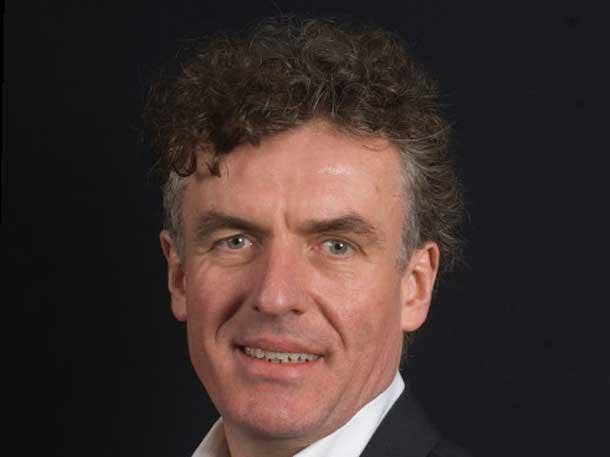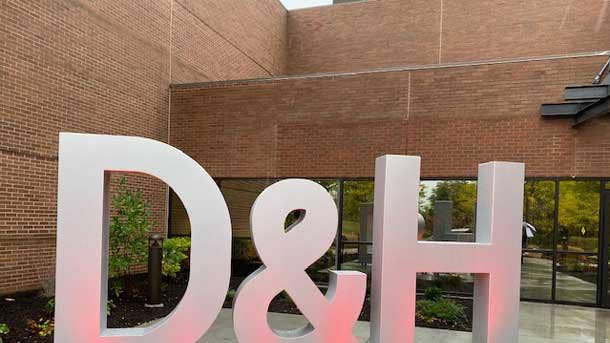Synnex’s Michael Urban: Synnex-Tech Data Merger Only Good, Even For Competitors
Michael Urban, president of worldwide technology solutions distribution at Synnex, tells CRN in an interview that any worries about the impact of the merger on competition or the SMB market are unfounded, and that the combined company ’will be fair competitors.’

’We Will Be Fair Competitors’
When two of the largest companies in any industry merge to become the largest, concerns about how that might impact competition and what will happen to the employees are natural.
However, Michael Urban, president of worldwide technology solutions distribution at Synnex, is trying to quell those concerns as Synnex and Tech Data move to merge and overtake long-time industry leader and archrival Ingram Micro as the largest IT distributor on the planet.
“The market is getting bigger. There’s more potential, and everybody will find their space. And that’s good… We will be big competitors in the market,” he said, when asked about competition from another rival, D&H. “But we will be fair competitors.”
Urban probably knows both Tech Data and Synnex better than just about anyone. He joined Synnex a bit more than two years ago after a six-plus-year stay at Tech Data where he left as corporate senior vice president of strategy, transformation, and global vendor management. That, combined with the fact that he was part of a relatively small group of people who planned the merger, gives him an insight that few have into the programs, processes, and people of both companies and what the combined company might look like.
That said, given that the acquisition was just announced and that the two companies will operated independently until (and if) it closes, Urban was very careful to not discuss changes that could happen as the two become one.
In the following slideshow, Urban offers insights on the impact the merger might have on the industry.

Have Synnex and Tech Data started reaching out to their solution providers yet? What have you been telling partners?
Of course, we called our customer partners and our vendor partners. The feedback is very good from the [channel] partner side. They see many upsides in this because, if you think about the future and where this is all going, the world’s changing as we know. Massively. Everything is going to the cloud world. We as distributors have many different platforms. And it’s an issue for partners because they like, if possible, to have only one platform instead of many different platforms. Also, the portfolio: If you look at cloud, the portfolio is so huge. But if a distributor can only deliver one solution, you might have to go to another distributor for another solution. And if you think about it from the end customer side, they also like solutions where they can serve their own licenses. And you can tell them, yeah, you can manage the Microsoft license through this platform, but the IBM license you have to manage through that platform. And not a lot of end customers can understand that. Maybe the resellers can manage that, but when it comes to the end customer’s site, it’s very complicated.
Of course, there’s questions about credit lines. As you can imagine, there’s good feedback about that. We provide the right credit lines to the partners because we have known them for a long time. We trust them. I don’t see any issues on that.
The next question, of course, from the customer side, what about my pricing? Has my pricing changed? My answer on that one is, it will not because there is still strong competition in the market. Why should we raise the price? The pricing is so low already, so there’s not much chance of that. The market is changing. You remember the pie in the old days where 75 percent of sales was hardware. And 25 percent was maybe software and services, which we merged into [a single category]. The pie has changed. First of all, it’s even bigger. That’s good news. At the same time, the service part and the software part are getting bigger and bigger. ... So the margin discussion is not really as important anymore. Maybe that was the case 10 years ago when the business was much more hardware-heavy, partly software, no services.

But won’t Synnex and Tech Data have to rationalize some platforms that would end up cutting some of the choice partners have?
Using the cloud platform as an example, Tech Data has StreamOne that was set up four years ago and totally rebuilt over time. In the last four years, they have done a lot of investment in this space. And they have had a couple of announcements that they will continue their investments there. We have developed our Stellr platform for many years. They are similar in a way, but different. And of course, if we come together, then we will merge the platforms together.
And the good news is, both platforms are based on HTML5, There’s no legacy [technology] in that. So it will be a quick combination of both. And both companies have different focus areas, so that means on-boarding vendors and bringing them together should be relatively quick. And then we can have a much broader platform for partners who will only have to deal with one platform in the future. They don’t have to go to the Tech Data platform or the Synnex platform any more.
The most important thing is, they have put their investment in [their platform], and we have put our investment in. For sure, there are some duplications. But now we can combine these and have an even more competitive platform for the future.

Synnex is somewhat known for being more quick to do what it takes to close a deal than other distributors, including Tech Data. How do you bring the two companies' processes for closing deals together?
Synnex is a very agile company. That was built up by the founders. Everything you see from Synnex is based on the platform that was started from the beginning of Synnex. I met [Synnex Founder and former Chairman] Bob Huang in 1997 the first time, and we talked about the platform. And it was in its early stage. He was the one who would always say, ’I’d like to bring this thing to the platform’ and ’This platform should support all our business’ and ’Having everything in the platform, you can make quick decisions.’ And that includes sales decisions on the pricing side. He was very active. ...
This heritage is still in the company. Synnex is a very agile company, very entrepreneurial driven. I’m talking specifically North America, because Tech Data in Europe is different. But in North America, we are more agile, we listen to the customers, and we can give a quick decision to a customer partner, or we can make a quick decision on the vendor side. We are known for making decisions in a fast way.
But how do you bring that to Tech Data, which has its own processes? How do you bring that nimbleness to your future colleagues there?
There are two things here. One is the people side, and one the system side. You can set up a system, but also you have to change the habits of people. For many years, I was driving the digital transformation journey. With the digital transformation journey, number one is people, habit, change. It’s not the system. You can build nice systems and they work great, but it’s all about people and change. I see exactly the same thing here. So if people use our system the day after the merge, that would mean people have changed. Maybe even the Synnex people will have changed a bit, because they are learning from the Tech Data side because [Tech Data also does] some things nice. So there are things we can combine here.
Again, the system side will drive the decision process, and the system from Synnex is a very agile system built on the distribution needs of every day. If we jointly decide to use Synnex’s customer information system, I think that the Tech Data guys will say, ’This is really great.’

In terms of partner communities, Synnex has Varnex, and Tech Data has TechSelect. What is the difference between those two, and how do you plan to bring them together?
First of all, [Synnex and Tech Data] have to get together before we do that.
Last year we rebuilt Varnex. It was at the beginning of the pandemic. We said we are creating a new Varnex, a different Varnex. Varnex is a very strong partnership of people meeting each other. It was driven by the marketing side. So we had a lot of activities, and came together with vendor partners, etc. With the new Varnex 2.0, we call it, we have moved more towards how we can support our partners better around our ’Solv’ [methodologies for building industry-specific solutions]. ...
The reality in the world today is that it’s very difficult for an SMB or medium-sized VAR to build up a complete solution for the end customer. But the end customers are asking for everything, right? Many end customers are asking for a public cloud solution, a private cloud solution, collaboration, endpoint devices, security, and so on. For many of our partners in the Varnex group, it’s very difficult to [offer] all the solutions. So what we said is, we can bring the Varnex members together in a trusted environment so they can complement each other and can go jointly to those end customers. Of course, one of the [channel partners] has the lead.
We as Synnex ensure that no one tries to steal a customer. It’s a community going to a customer and jointly selling a solution.
If you look at TechSelect, it also comes more out of the marketing side. I think it has changed as well over time. But I’m not sure that they are where we are now with Varnex. [But there will] be a good combination of both, bring the TechSelect and Varnex ideas together over time.

How do the partner programs differ between Synnex and Tech Data, and what do you do to bring them together?
Many of the partner programs are driven by the vendor side. They have their business models, and they want us as distributors to execute in a certain way, and that’s what we’re doing. And that has to do with the system integration because every vendor partner likes to be somewhat fully integrated, and today they have to talk to Tech Data and at the same time talk to Synnex and other distributors. ...
I know Tech Data has great programs in place, and Synnex has great programs in place. I believe we can put these two programs together, maybe running them parallel, because they have different tones. If the programs are similar, we will take the best of them. If they are different programs, we’ll run the different programs.
[Programs depend on] the end-customer side. For example, it might be government sales or industry sales. For example, hospital sales to us is big, governmental sales is big. And with the acquisition of DLT by Tech Data, they are also strong in the government market. It’s interesting that in the vertical markets, the [overlaps between Synnex and Tech Data] are not as big as we think. And if we bring that together, I think we’re capable of delivering for all verticals the right solutions to the end customer.
What are some things at Tech Data that you look at and think, 'Gee, I wish we had that at Synnex?'
There are some things, but really I don’t like to share them.
But it comes back to my point: They have really good things. We have good things. And if you combine them, I think it will be very complementary to the market. And again, I think customers love it, and the vendor feedback is also very positive from this because they know what we have done for them. They know what Tech Data has done for them.

One of the key values distribution brings to channel partners is credit, which can make or break a deal. Partners often depend on multiple distributors to get the right credit. How will this be impacted with one less distributor for partners to turn to?
I don’t see this as an issue. Look at the pandemic time last year. That I think is a perfect example. We extended our credit lines with our partners because in some cases the customers haven’t taken the goods. ’What can you do? Can you keep the products on your side and bill me?’ We have done that. We were capable of continuing the business with such partners. We gave extra credit lines there.
And at the same time, we do a lot of as-a-service [deals]. There’s a complete shift in the market from the classic ’I buy a piece of product for whatever and sell it’ to much more of as-a-service play. And as-a-service play means you charge on a monthly basis. ... So this is less of an issue than it was in the old days because of this transformation. Microsoft, as an example, is going completely away from the classic license. It’s history. So we have only as-a-service.
On the hardware side, we do much more as-a-service now and give partners a chance to have a package they sell to the end customer for three years and charge only a certain amount a month.
So credit lines are not as big an issue as they were five years ago. That’s why I feel very comfortable that we are capable of giving the right credit lines to our partners.

Once the acquisition closes, Tech Data-Synnex will be the largest distributor with total revenue exceeding that of Ingram Micro. Does this mean increased competition between the two distribution behemoths?
It depends really on the market place. You look too much at the U.S. market. If you go to Europe, there’s a heavy, strong competition on-going with Ingram, with Also, Arrow, with Westcon-Comstor, with Esprinet. There are still many, many distributors in the market that compete. Of course, Ingram will fight. Esprinet will fight. And Westcom will fight.
In Asia, there are hundreds of distributors. Highly-competitive market. Latin America, many distributors. Many small ones. But they have in their markets the right position and the right size. Heavy competition there.
And now of course, we come to the U.S. and to Canada. Similar thing. There’s one big distributor you just interviewed. (Editor’s note: Urban is referring to D&H.) That’s a $5-billion company. And they like to grow, and they believe they have a lot of opportunity. I get that. And they will. And our neighbors in Greenville. (Editor’s note: Urban is referring to ScanSource, based in Greenville, S.C.) They also will grow, and they’ll have their focus and they will take business for sure.
My point is this: The market will grow in the next years. I’m very positive about this year and the next and beyond, because digital transformation is accelerating over time, but with the COVID situation, even more. And we see that already. So if you see the volume side, the end-point side, it’s climbing. You heard Monday [President] Joe Biden was saying the U.S. will spend about $3 trillion in education and infrastructure. This is massive. And education means, maybe half goes to IT. Maybe a bit less, but I think that means huge Chromebook sales, notebook sales, classrooms, even working at home environments for students, and so on.
And data center spending is coming back. We see already a clear trend there. If you would not have the [current] component issue as we have been facing for a couple months, this would already be above the previous year. So there’s a clear trend: The data center comes back, end-point growing even faster, and software and the cloud side. So I’m very positive for this fiscal year. ...
The pie will grow bigger. And of course we’d like to have an important part of that. And we’d like to grow with the market and even beyond.

When CRN talked earlier this week with D&H, co-presidents Michael and Dan Schwab said that when the merger between Synnex and Tech Data is complete, they expect to see new opportunities to grow their midmarket and SMB business at the merged company's expense. How do you respond to that?
I would say time will tell. Synnex is a very strong SMB partner in the market, and Tech Data is also in the SMB space, but it is more in the enterprise side. I agree with that. But we’d like to play an important role in the SMB space. SMB is very important for us, and is clearly on our line card. This is not new for Synnex. It’s in our genes. And we continue on that path.
But again, [D&H] will find their space, I’m absolutely sure about that. And they will grow. Again, the market is getting bigger. There’s more potential, and everybody will find their space. And that’s good. ... We will be big competitors in the market. But we will be fair competitors.
What happens to the people as Synnex and Tech Data merge?
Of course, some people will get scared and wonder what this means for them. The first reaction is, ’Ooo, my job, is this job secure?’
What I’m saying is, the job is secure. The most important point is that everyone understands, and we said this during our town hall this week, that we’d like to keep every job because we will change in the digital transformation journey. Some people may have a different job tomorrow. But we need them. We have people in the company, and there’s a reason: We trust them, and we work with them. And if they believe their job will disappear, fine, but go with us and find another job within the company. On this digital transformation journey, there are so many changes in the market. We are big in digital transformation. We have invested a lot of money in the last couple of years, and we continue to invest, but we haven’t taken any people out. But we move people to different jobs, we train them with our own training centers, and this is something we can bring to the Tech Data side. And we bring our people to the next stage. We do promotions within the organization.